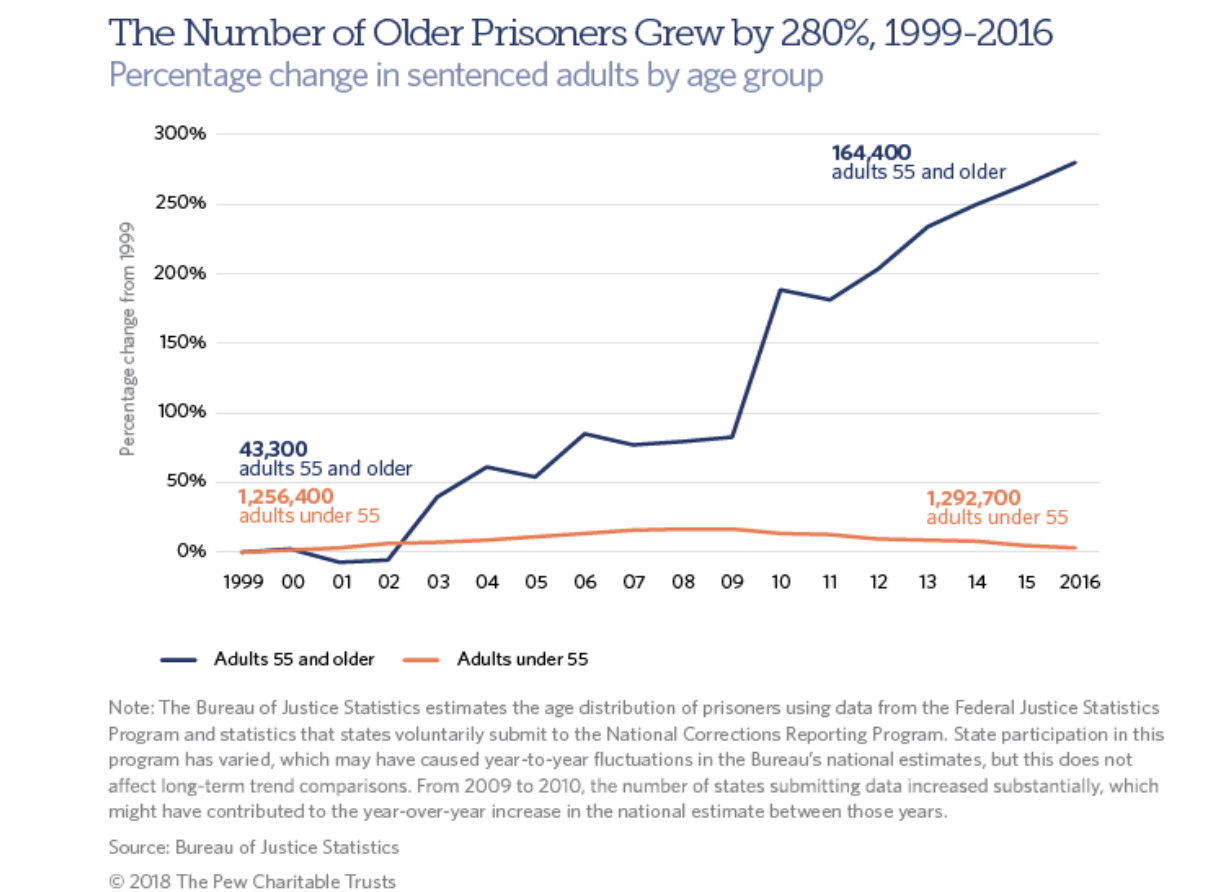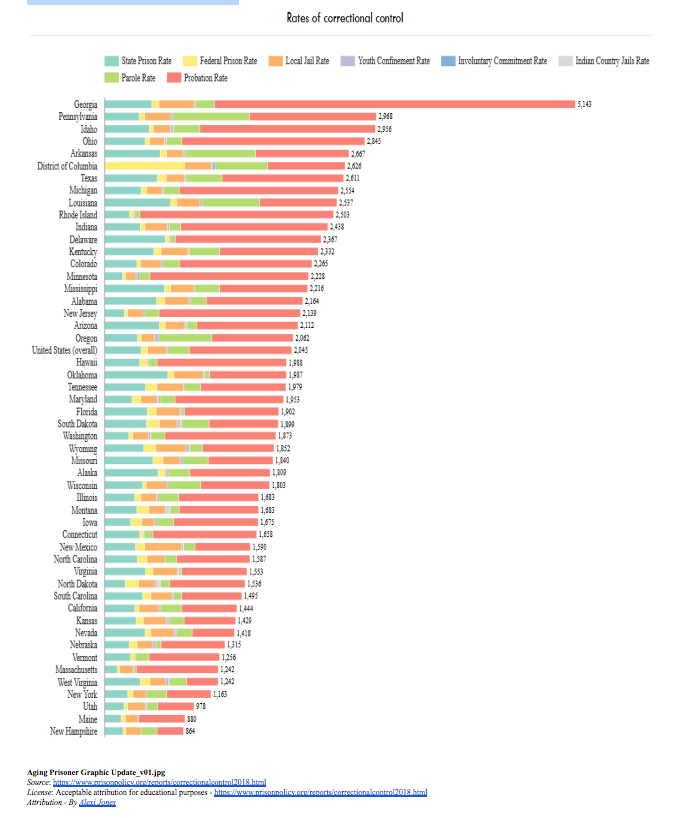9.15. Current Issues in Corrections: Aging and Overcrowding
David Carter
One of the side effects of lengthier sentences is that: the individuals in prison get older, in prison. Thus, the amounts of individuals in prisons over 55 years old has dramatically increased. As McKillop and Boucher (2018) relate in the graphic below, based on BJS data, there has been a 280% increase in prisoners, aged 55 and older. [1]
Aging Prisoners

And as the title of their article depicts, there is a growing cost within this subpopulation of inmates. McKillop and Boucher (2018) relay that the cost of this group of inmates can be upwards of three times the cost of the normal inmate (30k to 100k per inmate). [2]
Beyond just the cost of these inmates, a more philosophical question has risen, in regards to how to treat prisoners as they enter their last phase in life. Some have articulated compassionate releases for individuals who are entering hospice care or in need of assisted living conditions. Others articulate that this is unfair to put the burden on the inmate, as they have been incarcerated for long periods and have few self-support options available. In a powerful documentary on this matter, Edgar Barens details these issues. Information about this film, The Prison Terminal (2013), can be seen here: https://www.prisonterminal.com/.
Overcrowding
These issues and others have all contributed to the rising correctional population in the United States. It is estimated that we have over 8 million people in correctional control, and that number does not seem to be subsiding. Yes, there are reductions in certain areas, such as a decline in the prison population in the last few years, but this does not mean that they are not still under control. In one of the more detailed examples of just where individuals are at in corrections, Alexi Jones (2018) of the Prison Policy Initiative provides a graphic, based on State and Federal data to demonstrate this impact.
Rates of Correctional Control

Not only does this graphic demonstrate the overall volume of correctional control, but it also highlights how states are handling their populations differentially. The second half of Jones’ (2018) [3] report details the volume of individuals with each state. Please take a moment to review the last portion of this report to see how many are under correctional control, found here: https://www.prisonpolicy.org/reports/correctionalcontrol2018.html#statedata
Prison overcrowding is problematic for multiple reasons. First, when there are too many individuals (especially antisocial ones) within a facility, there are more assaults and injuries that occur within the institution. Moreover, there is a safety concern for not only inmate-on-inmate violence but also inmate-on-staff crimes. Second, the more people you have in a facility, the faster that facility wears down. Operating a jail or prison at maximum (or over maximum) capacity causes more items to break or wear out within the facility at a fast rate. Finally, when individuals are unable to access adequate health care because of the excessively long waits, due to overcrowding, it is a violation of their constitutional rights.
As prisoners, we (the public and the State) have a responsibility to house and properly care for the prisoners overseen. This is not to say that offenders are getting premier care, but that they are at least receiving a modicum of care. When this low level of care is deliberately denied due to excessive volumes of individuals, it is a violation of a person’s 8th Amendment rights against cruel and unusual punishment. As was found in the case of Estelle v. Gamble, (1976). [4] This similar issue was presented in California over ten years ago. A three-judge panel ruled with the prisoners, citing the need for California to reduce its prison population to a level where the individuals could effectively be managed, and cared for [emphasis on the latter]. Dealing with overcrowding is a constant issue for most prisons and jails. Some have resolved to release more out into the community at a higher volume, on parole, or just release. However, this too has its own set of problems, as reentry is now becoming the current issue within corrections.
- McKillop, M., & Boucher, A. (2018). Aging prison populations drive up costs. Older individuals have more chronic illnesses and other ailments that necessitate greater spending. Available at: https://www.pewtrusts.org/en/research-and-analysis/articles/2018/02/20/aging-prison-populations-drive-up-costs ↵
- McKillop, M., & Boucher, A. (2018). Aging prison populations drive up costs. Older individuals have more chronic illnesses and other ailments that necessitate greater spending. Available at: https://www.pewtrusts.org/en/research-and-analysis/articles/2018/02/20/aging-prison-populations-drive-up-costs ↵
- Jones, A. (2018). Correctional Control 2018: Incarceration and supervision by State Prison Policy Initiative. Available at: https://www.prisonpolicy.org/reports/correctionalcontrol2018.html#statedata. ↵
- Estelle v. Gamble, 429 U.S. 97 (1976). ↵

